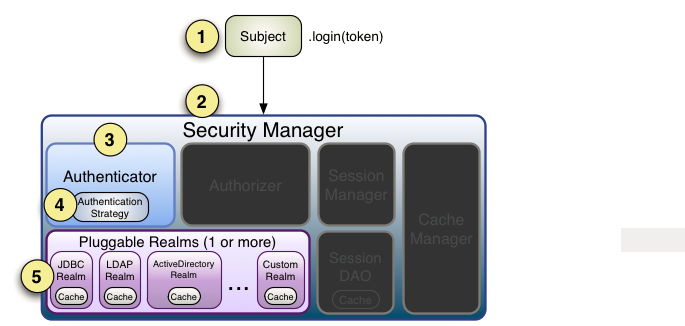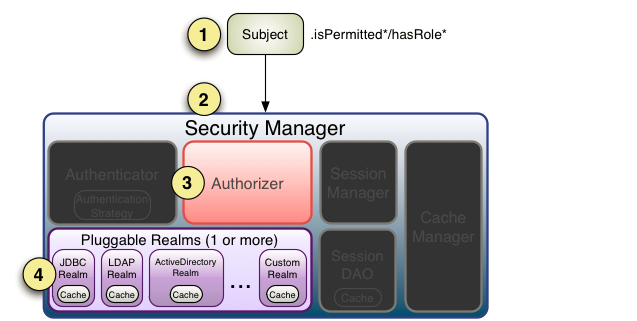一、身份验证
先来看看身份验证的流程

流程如下:
1、首先调用Subject.login(token)进行登录,其会自动委托给Security Manager,调用之前必须通过SecurityUtils. setSecurityManager()设置;
2、SecurityManager负责真正的身份验证逻辑;它会委托给Authenticator进行身份验证;
3、Authenticator才是真正的身份验证者,Shiro API中核心的身份认证入口点,此处可以自定义插入自己的实现;
4、Authenticator可能会委托给相应的AuthenticationStrategy进行多Realm身份验证,默认ModularRealmAuthenticator会调用AuthenticationStrategy进行多Realm身份验证;
5、Authenticator会把相应的token传入Realm,从Realm获取身份验证信息,如果没有返回/抛出异常表示身份验证失败了。此处可以配置多个Realm,将按照相应的顺序及策略进行访问。
测试案例:
/** * 登录验证 * @throws Exception */ @ResponseBody @RequestMapping(value = "/sys/login", method = RequestMethod.POST) public R login(String username, String password, String captcha)throws Exception { try{ Subject subject = ShiroUtils.getSubject(); UsernamePasswordToken token = new UsernamePasswordToken(username, password); subject.login(token); }catch (UnknownAccountException e) { return R.error(e.getMessage()); }catch (IncorrectCredentialsException e) { return R.error("账号或密码不正确"); }catch (LockedAccountException e) { return R.error("账号已被锁定,请联系管理员"); }catch (AuthenticationException e) { return R.error("账户验证失败"); } return R.ok(); }
2.5 Realm
Realm:域,Shiro从从Realm获取安全数据(如用户、角色、权限),就是说SecurityManager要验证用户身份,那么它需要从Realm获取相应的用户进行比较以确定用户身份是否合法;也需要从Realm得到用户相应的角色/权限进行验证用户是否能进行操作;可以把Realm看成DataSource,即安全数据源。如我们之前的ini配置方式将使用org.apache.shiro.realm.text.IniRealm。
2.6 Authenticator及AuthenticationStrategy
Authenticator的职责是验证用户帐号,是Shiro API中身份验证核心的入口点:
- public AuthenticationInfo authenticate(AuthenticationToken authenticationToken)
- throws AuthenticationException;
如果验证成功,将返回AuthenticationInfo验证信息;此信息中包含了身份及凭证;如果验证失败将抛出相应的AuthenticationException实现。
SecurityManager接口继承了Authenticator,另外还有一个ModularRealmAuthenticator实现,其委托给多个Realm进行验证,验证规则通过AuthenticationStrategy接口指定,默认提供的实现:
FirstSuccessfulStrategy:只要有一个Realm验证成功即可,只返回第一个Realm身份验证成功的认证信息,其他的忽略;
AtLeastOneSuccessfulStrategy:只要有一个Realm验证成功即可,和FirstSuccessfulStrategy不同,返回所有Realm身份验证成功的认证信息;
AllSuccessfulStrategy:所有Realm验证成功才算成功,且返回所有Realm身份验证成功的认证信息,如果有一个失败就失败了。
二、 授权
授权流程:

流程如下:
1、首先调用Subject.isPermitted*/hasRole*接口,其会委托给SecurityManager,而SecurityManager接着会委托给Authorizer;
2、Authorizer是真正的授权者,如果我们调用如isPermitted(“user:view”),其首先会通过PermissionResolver把字符串转换成相应的Permission实例;
3、在进行授权之前,其会调用相应的Realm获取Subject相应的角色/权限用于匹配传入的角色/权限;
4、Authorizer会判断Realm的角色/权限是否和传入的匹配,如果有多个Realm,会委托给ModularRealmAuthorizer进行循环判断,如果匹配如isPermitted*/hasRole*会返回true,否则返回false表示授权失败。
ModularRealmAuthorizer进行多Realm匹配流程:
1、首先检查相应的Realm是否实现了实现了Authorizer;
2、如果实现了Authorizer,那么接着调用其相应的isPermitted*/hasRole*接口进行匹配;
3、如果有一个Realm匹配那么将返回true,否则返回false。
如果Realm进行授权的话,应该继承AuthorizingRealm,其流程是:
1.1、如果调用hasRole*,则直接获取AuthorizationInfo.getRoles()与传入的角色比较即可;
1.2、首先如果调用如isPermitted(“user:view”),首先通过PermissionResolver将权限字符串转换成相应的Permission实例,默认使用WildcardPermissionResolver,即转换为通配符的WildcardPermission;
2、通过AuthorizationInfo.getObjectPermissions()得到Permission实例集合;通过AuthorizationInfo. getStringPermissions()得到字符串集合并通过PermissionResolver解析为Permission实例;然后获取用户的角色,并通过RolePermissionResolver解析角色对应的权限集合(默认没有实现,可以自己提供);
3、接着调用Permission. implies(Permission p)逐个与传入的权限比较,如果有匹配的则返回true,否则false。
测试用例:
/** * 授权(验证权限时调用) */ @Override protected AuthorizationInfo doGetAuthorizationInfo(PrincipalCollection principals) { User user = (User)principals.getPrimaryPrincipal(); Integer userId = user.getUserId(); List<String> permsList = null; //系统管理员,拥有最高权限 if(userId == 1){ List<Auth> menuList = authService.queryList(new HashMap<String, Object>()); permsList = new ArrayList<String>(menuList.size()); for(Auth menu : menuList){ permsList.add(menu.getPerms()); } }else{ permsList = userService.queryAllPerms(userId); } //用户权限列表 Set<String> permsSet = new HashSet<String>(); for(String perms : permsList){ if(StringUtils.isBlank(perms)){ continue; } permsSet.addAll(Arrays.asList(perms.trim().split(","))); } SimpleAuthorizationInfo info = new SimpleAuthorizationInfo(); info.setStringPermissions(permsSet); return info; }